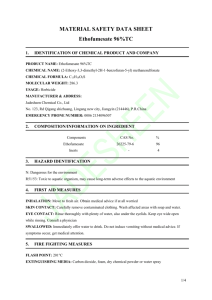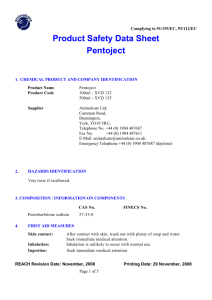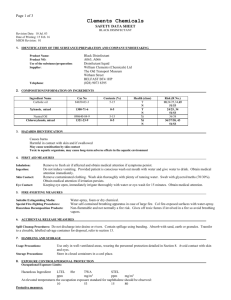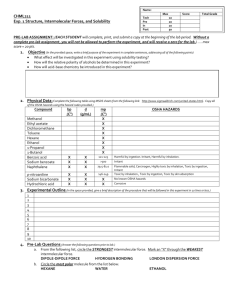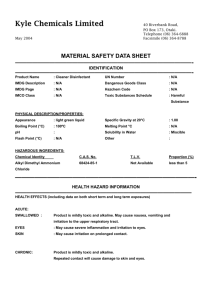Genscript Corporation
advertisement
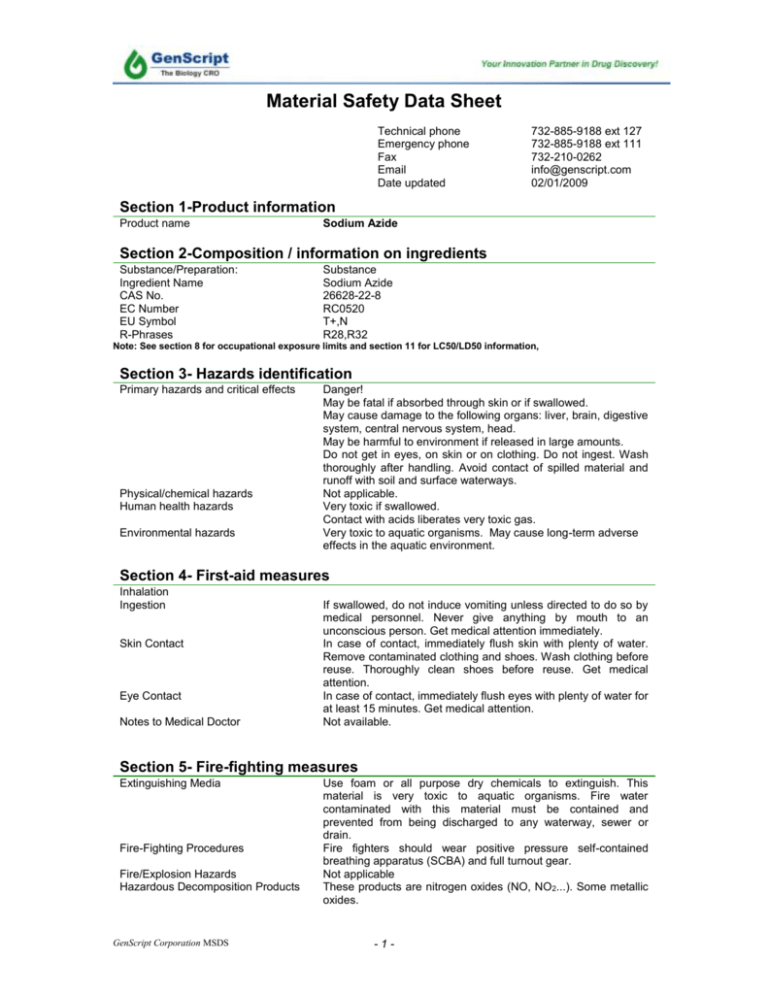
Material Safety Data Sheet Technical phone Emergency phone Fax Email Date updated 732-885-9188 ext 127 732-885-9188 ext 111 732-210-0262 info@genscript.com 02/01/2009 Section 1-Product information Product name Sodium Azide Section 2-Composition / information on ingredients Substance/Preparation: Ingredient Name CAS No. EC Number EU Symbol R-Phrases Substance Sodium Azide 26628-22-8 RC0520 T+,N R28,R32 Note: See section 8 for occupational exposure limits and section 11 for LC50/LD50 information, Section 3- Hazards identification Primary hazards and critical effects Physical/chemical hazards Human health hazards Environmental hazards Danger! May be fatal if absorbed through skin or if swallowed. May cause damage to the following organs: liver, brain, digestive system, central nervous system, head. May be harmful to environment if released in large amounts. Do not get in eyes, on skin or on clothing. Do not ingest. Wash thoroughly after handling. Avoid contact of spilled material and runoff with soil and surface waterways. Not applicable. Very toxic if swallowed. Contact with acids liberates very toxic gas. Very toxic to aquatic organisms. May cause long-term adverse effects in the aquatic environment. Section 4- First-aid measures Inhalation Ingestion Skin Contact Eye Contact Notes to Medical Doctor If swallowed, do not induce vomiting unless directed to do so by medical personnel. Never give anything by mouth to an unconscious person. Get medical attention immediately. In case of contact, immediately flush skin with plenty of water. Remove contaminated clothing and shoes. Wash clothing before reuse. Thoroughly clean shoes before reuse. Get medical attention. In case of contact, immediately flush eyes with plenty of water for at least 15 minutes. Get medical attention. Not available. Section 5- Fire-fighting measures Extinguishing Media Fire-Fighting Procedures Fire/Explosion Hazards Hazardous Decomposition Products GenScript Corporation MSDS Use foam or all purpose dry chemicals to extinguish. This material is very toxic to aquatic organisms. Fire water contaminated with this material must be contained and prevented from being discharged to any waterway, sewer or drain. Fire fighters should wear positive pressure self-contained breathing apparatus (SCBA) and full turnout gear. Not applicable These products are nitrogen oxides (NO, NO2...). Some metallic oxides. -1- Section 6- Accidental release measures Personal precautions Environmental Precautions and Clean-up Methods Immediately contact emergency personnel. Keep unnecessary personnel away. Use suitable protective equipment (Section 8). Follow all fire fighting procedures (Section 5). If emergency personnel are unavailable vacuum or carefully scoop up spilled materials and place in an appropriate container for disposal. Avoid creating dusty conditions and prevent wind dispersal. Minimize contact of spilled material with soils to prevent runoff to surface waterways. Note: See section 1 for emergency contact information and section 13 for waste disposal. Section 7-Handling and storage Handling Storage Packaging materials Do not get in eyes, on skin or on clothing. Do not ingest. Wash thoroughly after handling. Avoid contact of spilled material and runoff with soil and surface waterways. Keep container tightly closed. Keep container in a cool, wellventilated area. Use original container. Section 8-Exposure controls/personal protection Occupational Exposure Limits Engineering controls Personal protective equipment Respiratory System Skin and body Hands Eyes Not available Open handling is not permitted. All handling must be performed in a glove box or other totally enclosed system. Use an approved, properly fitted, HEPA filter cartridge respirator, or a respirator of greater protection if there is the potential to exceed the exposure limit(s). Disposable outer garments, or impervious garments of equal or greater protection. Use chemical resistant, impervious gloves. Additional body garments should be used based upon the task being performed (e.g., sleevelets, apron, gauntlets, disposable suits) to avoid exposed skin surfaces. Appropriate techniques should be used to remove potentially contaminated clothing. Safety glasses. Goggles, face shield, or other full-face protection if potential exists for direct exposure to dust. Protective Clothing (Pictograms) Section 9- Physical and chemical properties Flash point Not available Section 10- Stability and reactivity Stability Conditions and Materials to avoid Hazardous Decomposition Products The product is stable. Reactive with metals, acids. Not available Section 11- Toxicological information Toxicity Data Routes of Entry Test Result Route Species LD50 27 mg/kg Oral Rat LD50 27 mg/kg Oral Mouse LD50 23.7 mg/kg Oral Birds LD50 20 mg/kg Dermal Rabbits LDLo 129 mg/kg Oral Human LDLo 143 mg/kg Oral Human LDLo 29 mg/kg Oral Human Absorbed through skin. Dermal contact. Eye contact. Inhalation. Ingestion. Acute toxicity GenScript Corporation MSDS -2- Ingestion Skin Contact Chronic toxicity Adverse Effects Target Organs Carcinogenic Effects Mutagenic Effects Developmental and Teratogenic Effects Reproductive Effects Other Information Very toxic if swallowed. Very toxic in contact with skin. Adverse symptoms may include: nausea/vomiting headache blood pressure lowered nerve damage central nervous system depression liver abnormalities cerebral (brain) pathology. May cause damage to the following organs: liver, brain, digestive system, central nervous system (CNS), head. Not available Not available Not available Not available Repeated exposure to a highly toxic material may produce general deterioration of health by an accumulation in one or many human organs. Section 12- Ecological information Ecotoxicity Data Species Period Result Not available Not available Not available Section 13- Disposal considerations Waste Handling and Disposal Waste must be disposed of in accordance with federal, state and local environmental control regulations. Section 14- Transport information Air Proper shipping name UN/ID Number IATA-DGR Class Packing Group Not applicable Not applicable Not controlled under IATA. Not applicable Section 15- Regulatory information EU Regulations Hazard Symbol(s) Risk Phrases Safety Phrases U.S. Federal Regulations Haz-Com Standard EPA State Canadian Regulations WHMIS CEPA Provincial GenScript Corporation MSDS C; N; T R28- Very toxic if swallowed. R32- Contact with acids liberates very toxic gas. R36/37/38- Irritating to eyes, respiratory system and skin. R50/53- Very toxic to aquatic organisms, may cause long-term adverse effects in the aquatic environment. S26- In case of contact with eyes, rinse immediately with plenty of water and seek medical advice. S28.1- After contact with skin, wash immediately with plenty of water. S36- Wear suitable protective clothing. S45- In case of accident or if you feel unwell, seek medical advice immediately (show the label where possible). S60- This material and its container must be disposed of as hazardous waste. S61- Avoid release to the environment. Refer to special instructions/Safety data sheets. CLASS: Highly toxic. CLASS: Target organ effects. TSCA 8(b) inventory: Sodium Azide TSCA 8(d) H and S data reporting: Sodium Azide SARA 313 toxic chemical notification and release reporting: Sodium Azide 50% Not available. CLASS D-1A: Material causing immediate and serious toxic effects (VERY TOXIC). No products were found. No products were found. -3- Section 16- Other information GenScript corporation MSDS is believed to be correct but only used as a guide for experienced personnel, GenScript shall not be held liable for any damage resulting from the handling or from contact with the above product. GenScript Corporation MSDS -4-

